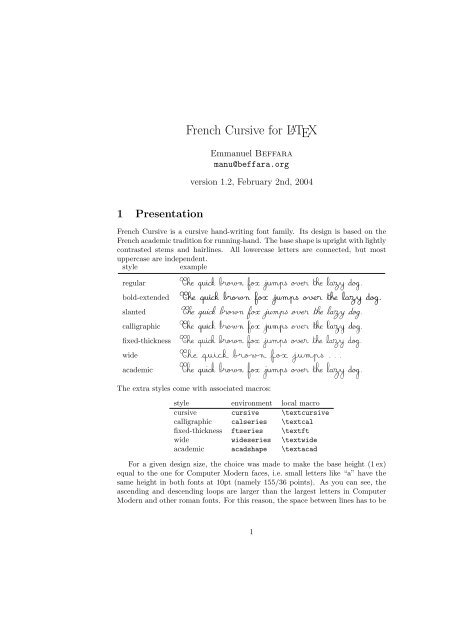Create successful ePaper yourself
Turn your PDF publications into a flip-book with our unique Google optimized e-Paper software.
<strong>French</strong> <strong>Cursive</strong> <strong>for</strong> L A TEXEmmanuel Beffaramanu@beffara.orgversion 1.2, February 2nd, 20041 Presentation<strong>French</strong> <strong>Cursive</strong> is a cursive hand-writing font family. Its design is based on the<strong>French</strong> academic tradition <strong>for</strong> running-hand. The base shape is upright with lightlycontrasted stems and hairlines. All lowercase letters are connected, but mostuppercase are independent.styleexampleregularbold-extendedslantedcalligraphicfixed-thicknessT‚h`e `qfi˚u˚i`c‚kffl ˜b˘r`o“w“nffl ˜f´o“x ¯jˇu‹m¯p¯s `o“vfleˇrffl ˚t‚h`e ˜l´åz›y `d`oˆg.T‚h`e `qfi˚u˚i`c‚kffl ˜b˘r`o“w“nffl ˜f´o“x ¯jˇu‹m¯p¯s `o“vfleˇrffl ˚t‚h`e ˜l´åz›y `d`oˆg.T‚h`e `qfi˚u˚i`c‚kffl ˜b˘r`o“w“nffl ˜f´o“x ¯jˇu‹m¯p¯s `o“vfleˇrffl ˚t‚h`e ˜l´åz›y `d`oˆg.T‚h`e `qfi˚u˚i`c‚kffl ˜b˘r`o“w“nffl ˜f´o“x ¯jˇu‹m¯p¯s `o“vfleˇrffl ˚t‚h`e ˜l´åz›y `d`oˆg.T‚h`e `qfi˚u˚i`c‚kffl ˜b˘r`o“w“nffl ˜f´o“x ¯jˇu‹m¯p¯s `o“vfleˇrffl ˚t‚h`e ˜l´åz›y `d`oˆg.wide T‚h`e `qfi˚u˚i`c‚kffl ˜b˘r`o“w“nffl ˜f´o“x ¯jˇu‹m¯p¯s . . .academicT‚h`e `qfi˚u˚i`c‚kffl ˜b˘r`o“w“nffl ˜f´o“x ¯jˇu‹m¯p¯s `o“vfleˇrffl ˚t‚h`e ˜l´åz›y `d`oˆg.The extra styles come with associated macros:style environment local macrocursive cursive \textcursivecalligraphic calseries \textcalfixed-thickness ftseries \textftwide wideseries \textwideacademic acadshape \textacadFor a given design size, the choice was made to make the base height (1 ex)equal to the one <strong>for</strong> Computer Modern faces, i.e. small letters like “a” have thesame height in both fonts at 10pt (namely 155/36 points). As you can see, theascending and descending loops are larger than the largest letters in ComputerModern and other roman fonts. For this reason, the space between lines has to be1
augmented a lot. We must actually use a \linespread value of 3/2 in paragraphsthat contain cursive text.Inter-letter links are inserted using a complex ligature system. Since ligaturesare incompatible with TEX’s way of composing accented letters, all accented lettershave to be provided by the font itself, there<strong>for</strong>e the encoding used is T1. Thoughtechnically the font can be used in standard OT1 encoding, this is only suitable ifno accented character is to be used, there<strong>for</strong>e OT1 encoding is not the default.2 InterfaceOT1default1 \NeedsTeXFormat{LaTeX2e}2 \ProvidesPackage{frcursive}3 [2004/02/01 v1.2 support package <strong>for</strong> <strong>French</strong> <strong>Cursive</strong>]2.1 Package optionsThe default encoding used <strong>for</strong> the font is T1, but we provide the option “OT1” touse this encoding instead.4 \newcommand{\frcursive@enc}{T1}5 \DeclareOption{OT1}{%6 \renewcommand{\frcursive@enc}{OT1}}By default we don’t change the font <strong>for</strong> the whole document. However, one mightwant to typeset a whole text in <strong>French</strong> <strong>Cursive</strong>. For this purpose, we provide theoption “default”. We must delay the redefinition of the default face in order totake care of these encoding issues.7 \newif\if@frcursive@default8 \@frcursive@defaultfalse9 \DeclareOption{default}{%10 \@frcursive@defaulttrue}These are the only options we provide.11 \ProcessOptions\relaxNow we can change fonts if asked <strong>for</strong> it.12 \if@frcursive@default13 \renewcommand{\rmdefault}{frc}14 \linespread{1.5}15 \RequirePackage[T1]{fontenc}16 \fi\cursive2.2 MacrosThe main macro we define is obviously the one that switches to cursive font.What it has to do is change the font family and encoding, and also change theline spread, because letters in <strong>French</strong> <strong>Cursive</strong> are larger. We define this as anenvironment because it can be used either in plain TEX style as {\cursive text}or as a L A TEX environment.2
I took this idea from C. Verchery’s typeface family Plum. His approach wasto create a version (named Seyes) with the lines in them. Although this wouldbe rather trivial to implement with Metafont, it would not work with TEX, inparticular because of its handling of spaces. There<strong>for</strong>e my approach is to putthe rules using TEX commands, which also allows, <strong>for</strong> instance, <strong>for</strong> changing theircolor independently of the text.\seyesThickness\seyesDefault\seyesThe default thickness of the rules will be a twentieth of a millimeter, which canbe changed be redefining the \seyesThickness length:32 \newlength{\seyesThickness}33 \setlength{\seyesThickness}{0.05mm}The default code <strong>for</strong> changing colors is contained in \seyesDefault, which isempty by default. One can redefine it <strong>for</strong> instance to \color{blue} to make therules blue.34 \newcommand{\seyesDefault}{}The main macro thus takes the text as argument and behaves as a box with thistext in it and the lines behind. The width of the box is the one of the text, whileits height and depth are the maximal ones in the font. We actually take referencecharacters to define the height of each line, so that it works with any font. Howeverthe result is strange when not using the academic shape of <strong>French</strong> <strong>Cursive</strong>.35 \newsavebox{\seyes@box}36 \newlength{\seyes@ln}37 \newcommand{\seyes}[2][\seyesDefault]{%38 \mbox{%39 \sbox\seyes@box{#2}%40 #1%41 \raisebox{-0.5\seyesThickness}{\mbox{%42 \rlap{\rule{\wd\seyes@box}{\seyesThickness}}%43 \settoheight\seyes@ln{a}%44 \rlap{\rule[\seyes@ln]{\wd\seyes@box}{\seyesThickness}}%45 \settoheight\seyes@ln{d}%46 \rlap{\rule[\seyes@ln]{\wd\seyes@box}{\seyesThickness}}%47 \settoheight\seyes@ln{b}%48 \rlap{\rule[\seyes@ln]{\wd\seyes@box}{\seyesThickness}}%49 \settodepth\seyes@ln{p}%50 \rlap{\rule[-\seyes@ln]{\wd\seyes@box}{\seyesThickness}}%51 \settodepth\seyes@ln{g}%52 \rlap{\rule[-\seyes@ln]{\wd\seyes@box}{\seyesThickness}}%53 }}%54 \usebox\seyes@box}}4

















